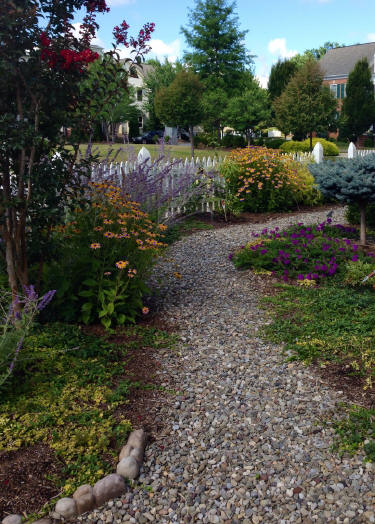Sheryl Massaro
Frederick County Master Gardener
 Thereís no scent I love more than that of a newly mowed lawn. For the past 4 years, though, no grass has been cut in my yard, because it has none. What grass I used to have fled to grass heaven. My old reel mower went to ReStore. If you also are considering going lawnless, here is a recap of my
small suburban yardís transition from degrassification to a land of drought-tolerant blooms. It might give you some ideas.
Thereís no scent I love more than that of a newly mowed lawn. For the past 4 years, though, no grass has been cut in my yard, because it has none. What grass I used to have fled to grass heaven. My old reel mower went to ReStore. If you also are considering going lawnless, here is a recap of my
small suburban yardís transition from degrassification to a land of drought-tolerant blooms. It might give you some ideas.
To begin, a word on the back yard. Iím one of those gardeners who doesnít grow many vegetables. When I settled in Urbana in 2010, Iíd already hardscaped the back and sides of the brand new property, leaving a foot of soil between stone and a privacy fence for just a few ediblesóasparagus, the annual tomato, a thornless blackberry, and my precious little fig. I have some
shade in the back, with hosta, real geraniums, hydrangea, and lots of odds and ends. Lots. The back yard is The Part Shade Experiment.
The more challenging front yard is The Full Sun Experiment. Facing due South, it bakes for 10-14 hours per day in summer. I settled on the property in July and the front lawn got sadder over the rest of that summer. The azaleas planted by the builder were sad, too, and also some sorry little evergreens. Nobody was happy.
I did have a vision, though, of a winding path of small stones bisecting flower beds extending 3 feet from the house and, on the other side of the path, 3 feet from the picket fencing. Since no one else in the community had removed their grass, I decided that working with a commercial nursery to submit a professional plan was the safest way to get approval from the HOA.
New plantings were detailed, including their sizes at planting time and again at maturity. The plan was approved quickly, the existing plants were dug up and are now happy on friendsí acreage in Mt. Airy, and the nursery came in and took up the grass. That is hard to do. They have a machine.
Now, Russian sage; white, deep pink, and golden yellow rudbeckia; Joe Pye weed; a few old roses; a couple of mugo pines; clematis; hardy hibiscus; two kinds of boxwood; plumbago; and a big lovely Arapaho crape myrtle thrive throughout most of the summer. Currently blooming is my favoriteóJapanese anemoneódusty pink petals with a golden center on long, graceful stalks.
Iíve also been establishing hardy verbena, vinca, and sedum as ground covers over the mulch. By late summer, the Homestead Purple verbena makes a stunning carpet under the mugo pines. Beautiful. In The Part Shade Experiment area, Iíve established Creeping Jenny and vinca as groundcovers.
Once established (about 3 years), none of these plants need much watering. Many are cut close to the ground after the first frost and, by May, are again spilling over the top of the picket fence.
Read:
Honey, I'm not going to cut the lawn anymore